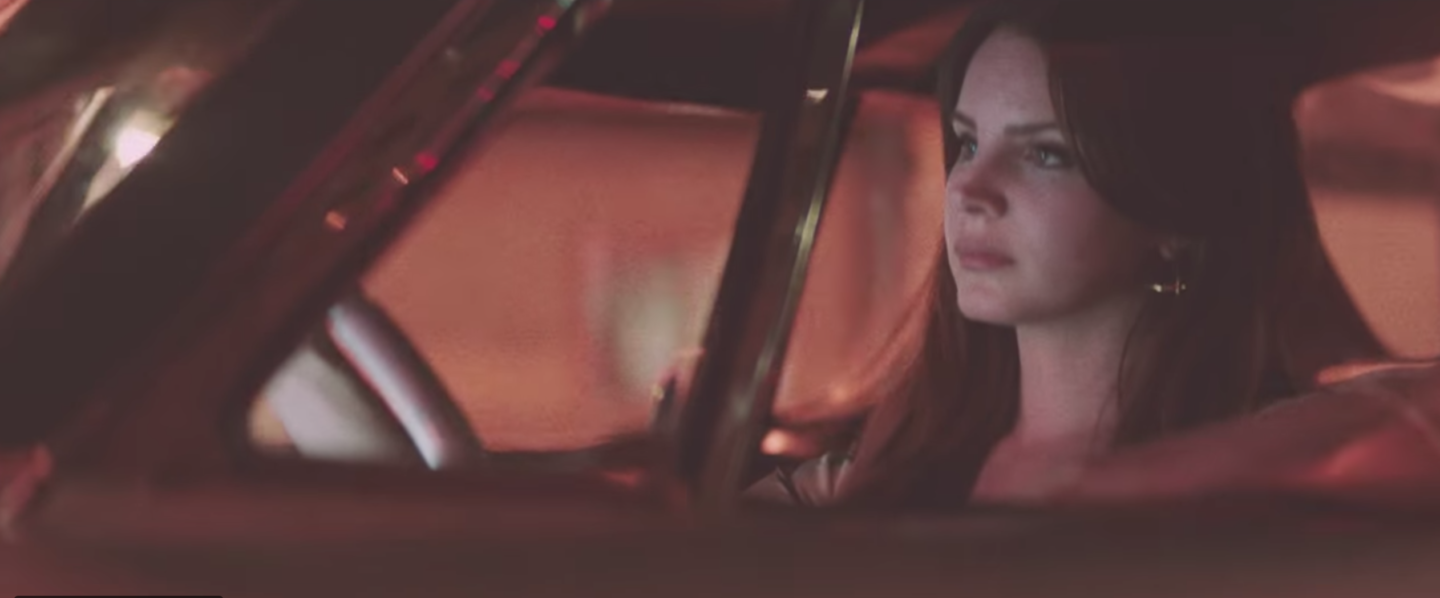A subsequent snippet of the intro released yesterday was the final buildup to the complete product, now being given such adjectives as “futuristic.” And yes, there is a certain Jetsons-y quality to the massive CGI’d Hollywood Hills home the camera slowly zooms in on (it’s got “High by the Beach” isolation overtones for sure, proving Del Rey’s canon is now large enough to be self-referential–in addition to constantly referencing other artists of the past). More than the future, however, “White Mustang” harkens to the past, specifically Madonna’s video take on L.A. from the early 80s and early 90s.

In “Burning Up,” directed by Steve Barron (hot off directing “Billie Jean”), another elusive male blonde who is literally and figuratively in the driver’s seat, takes over Madonna’s emotions as she writhes in yearning in the middle of the road. Played by her then “in real life” boyfriend, Norris Burroughs, the emotion Madonna exudes is a bit more intense than the understated looks LDR flashes to Eðvarð, preferring instead the way touch can speak for itself.
Touch has its limits when love is strained, however, and a transition scene of Del Rey running her fingers across a wall outside (“Take A Bow”-style) leads to a shot of Eðvarð alone in a modern recording studio (which would have also worked well for a video of “Best American Record” had it not remained unreleased). Even the neon boombox projected in front of Eðvarð bears a certain nod to the “Burning Up” era, Madonna constantly photographed with or next to one in those days. A morose Del Rey comes up to him from behind, but his lack of interest has her heading for the window, staring out into the abyss of L.A. Norris also shares the same apathy toward his so-called beloved while driving aimlessly in search of Madonna, utterly unaware of her frantic state over his detachment in between floating around on a boat and dancing about in front of various antiquated items, like a vintage truck similar to the one that appears on the cover of Lust for Life.

At a house party where Eðvarð performs, Del Rey approaches him to give him a kiss, one he doesn’t immediately realize is intended to signify goodbye. When he does, it’s too late, she’s already driving with resignation through the numerous twisting and turning arteries of the city, which is where the echo of “Deeper and Deeper” comes in, director Bobby Woods filling many scenes with images of M driving through the streets and freeways. Already tinged with the “old Hollywood” vibe of the music industry Del Rey is so fond of, Andy Warhol star Udo Kier appears next to recording equipment in the opening scene as he shouts, “Our idols and demons will pursue us until we learn to let them go!” This aphorism indeed seems to be plaguing Del Rey as she grapples with letting go of her former god: this much too petite for her in stature rocker boyfriend.
When he finally catches up with Del Rey, they do a final dance that ends with her pushing him back to his own direction, a parallel to Madonna being in the driver’s seat at the end of “Burning Up”–both possessing the thematic implications that ultimately the woman is in control. Interspersed party scenes match up to the interspersed club scenes of “Deeper and Deeper,” with Madonna ultimately becoming disillusioned with that which she was initially glamored by. Thus, she, too, takes to the L.A. streets in a sleek car to escape from the one she is no longer enchanted with.

Where physical presentation is concerned, Del Rey and Madonna each have their meticulousness when it comes to their specific looQ. Of the “Burning Up” video, Barron has said, “We shot for two nights in Los Angeles… It was a bit of a mish-mash of a video. She trusted me, definitely. She handed it over, which she probably shouldn’t have done in retrospect. But she obviously wanted to be very much in control of how she looked and how she was dressed. Her dress was the most important thing that she wanted to talk about.” One gets the sense that this is the case for Del Rey as well, her constant update on Priscilla Presley’s beehive and loose-fitting, low-cut floral dress a continuation of the steez from “High By the Beach.”

Hence, for someone who never gets compared to Madonna, Del Rey’s visuals–and fastidiousness about them–are certainly comparable to M’s own homages to the ironically nicknamed City of Angels in this video. And that’s just fine.



















